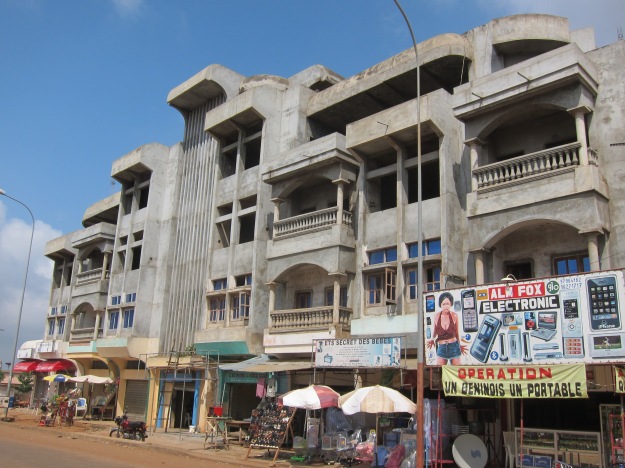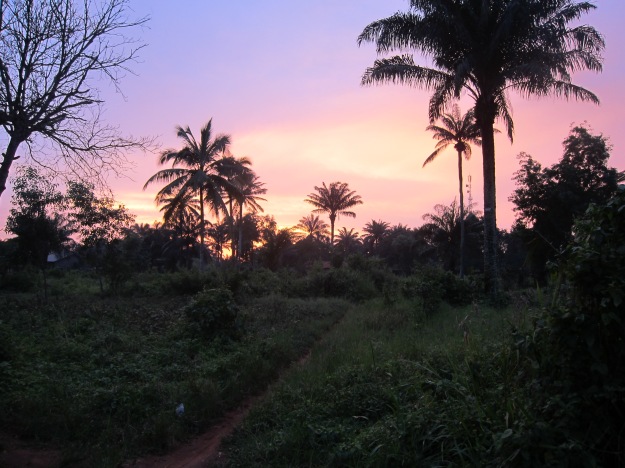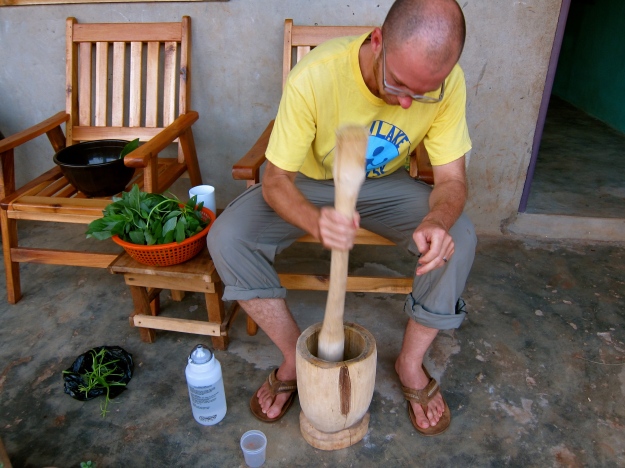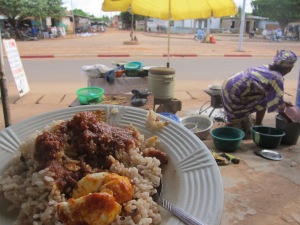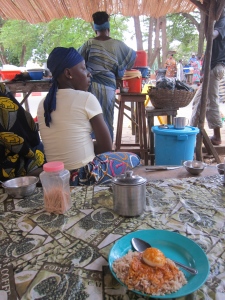Cinder blocks (made locally) and concrete dominate as building materials, especially in larger towns and cities. This building is down the street from our host family’s house in Porto Novo, Benin’s capital. The store on the bottom right of the photo sells cell phones, the store to the left of that sells baby accessories, and the next to the left is a locally made shoe shop. The sign on the cell phone store, “Operation Un Beninois Un Portable” roughly translates to “A cell phone for each Beninoise”. Cell phones and cell phone stores are ubiquitous. Most people have a cell phone. Lots of people carry multiple cell phones, each with a sim card from a different cell phone company to maximize coverage. Land lines are rare. A Peace Corps volunteer who served here ten years ago and recently returned to visit said that the proliferation of cell phones is perhaps the biggest differences between Benin now and Benin ten years ago.
Monthly Archives: November 2012
Knife from Market
I brought my Henckels chef’s knife with us. But I couldn’t resist buying this hand-made knife in our market. The handle is hand carved from wood and was rough. Several splinters convinced me to sand it down. The blade was extremely sharp when I bought it but the metal in the blade is weak and has developed lots of nicks already. Still, a fun purchase at about $1.00.
Woman with Baby and Greens
Women are the primary care givers for kids here and carry their babies with them to do housework, to go shopping or, like this woman, while they sell items in the market. In addition to the stalls in the market, lots of people carry items (mostly on their heads) to sell. A head nod is usually enough to get them to stop and sell you whatever it is they have. I don’t know the name of the plant that she is selling but it is used as a traditional medicine to treat upset stomachs. The leaves are soaked in hot water and the ensuing tea drunk.
Leftovers – Jerk Chicken Sandwich
Yesterday I came home hungry. There was leftover jerk chicken from the previous night’s dinner. (I had used the jerk seasoning recipe from Mark Bittman’s How to Cook Everything). Usually I don’t like chicken breasts as they are dry and boring but the breasts were the winner on this chicken. Local Beninese chickens run free and eat whatever bugs and grains they can find. Thus, their meat is tougher and less fatty than the plump, juicy chicken we get in the U.S. I also burned the hell out of the legs and thighs as I put them on the grill before the charcoal had sufficiently died down. But I digress. Back to lunch.
Jen had bought a baguette with—you guessed it—spicy tomato sauce and left me half. Inspiration struck. I shredded the leftover chicken breast, chopped up some fresh pineapple and red onion and then piled it on the baguette. Hmmmm… Close, but it needed something. The cilantro and mint growing on our patio aren’t ready to eat yet so I tore some basil leaves from the bush that I was given a couple of weeks ago. Sandwich now complete, I took a hungry-boy bite: a clear winner.
Don’t have any Beninese spicy tomato sauce on hand? Substitute some mayonnaise or a little olive oil and vinegar or whatever else you like on a sandwich. Any herb would be great though I think cilantro, mint, basil or a combination would be best. Try it. Let me know what you think.
Grilling: Jerk Chicken, Pineapple, Onions
I bought a grill for $2 at our market; the grate for cooking cost me another $2. I grill in the shared yard in front of our house. Cooking is almost exclusively the domain of women here so I get some funny looks and questions from our neighbors when I’m cooking.
Dinner: Grilled jerk chicken, pineapple and onions with sweet potato fries, cabbage & carrot salad. I burnt the chicken a bit as I’m still getting used to the new grill. The sweet potato fries were the winner this night.
Sunday Bike Ride
Jen and I set out one recent Sunday for a long bike ride. The map we have shows about a half dozen roads in our area but there are hundreds of dirt roads like this that crisscross the area. It’s a lot of fun to explore the roads and see where we end up. Those are palm trees (for palm oil) on the left and small corn plants in the rows immediately to the right of the road. Papaya trees are behind the corn in the right of the picture.
A farmer that we stopped to chat with along the ride standing with his bike. There’s manioc growing behind him and some sweet potatoes in the right side of the photo.
Jen zipping through the fields and trying to catch bugs in her mouth.
With Pilon
Here I’m on our porch using a mortar and pestle that I bought at the market to grind spices. It cost $4 U.S. dollars. Later while pounding some beans to make falafel, I cracked our concrete kitchen floor. I’ve subsequently been using the pilon exclusively outside. I don’t know the name of the greens in this picture but they have a mild flavor similar to spinach.
Thanksgiving Addition: What We’re Eating in Benin
- Lunch: rice, beans, spicy tomato sauce and an egg at a stand on the side of the road in Benin’s capital, Porto Novo.
Before starting the Peace Corps, I spent my longest time outside of the U.S. studying abroad in Italy. I am crazy about Italian food and it weighed heavily in my decision to study in Bologna for a year of college. I was surprised, however, that Italians eat almost exclusively Italian food. Bologna had one American-style restaurant that served low-grade renditions of burgers, steaks and ribs. There was one Mexican restaurant that, with ample margaritas, would suffice in a pinch but whose cuisine approximated the lunch buffet at ChiChi’s. A McDonalds rounded out the international cuisine offerings alongside the hundreds of places serving Italian food. Yes, it was to-die-for Italian food. Bologna is nicknamed La Grassa (The Fat) for a reason. It is the heart of Italian cuisine, the capital of the Emilia Romagna region where Parmesan cheese, Prosciutto ham, balsamic vinegar, mortadella, tortellini, Bolognese sauce and more originate. But even with all of these delicacies, I occasionally overpaid for an under seasoned, overcooked burger at the American style restaurant. In the immortal words of Patrick Henry, “Give me culinary variety or give me death.”
Excluding its biggest city, Cotonou, eating out in Benin offers little variability. Our town near the capital, Porto Novo, has nothing outside of Beninese cuisine. No American or Italian or Thai or Lebanese or Mexican or anything else. Beninese. Rice with spicy tomato sauce. Rice and beans with spicy tomato sauce. Pate, a cornmeal or manioc-based starchy food similar to cooled and congealed polenta, with spicy tomato sauce. Spaghetti with spicy tomato sauce. Spaghetti and rice with spicy tomato sauce. More rarely, pate with vegetable sauce. Sometimes you can add your choice of a spoonful of cooked beans or a chunk of cooked fish or a hardboiled egg or a fried hot dog (low grade; no Nathan’s or Sabrett’s here) or fried plantains for an extra 20 cents, or some gari (dried and pulverized manioc) for 5 cents. That’s about it.
In terms of cuisine, New York ruined me for life. I planned weekend outings around food adventures. A typical weekend went like this: Saturday around 11 am, head to Manhattan’s Chinatown for a banh mi, a half dozen pork dumplings, a scallion pancake, and an order of Korean-style fried chicken, each from a different hole-in-the-wall place. Then a half hour digestive walk to the East Village for a beer, wings and college football. Dinner offered dozens of cuisine choices: French, German, Russian, Polish, Italian, Romanian, Icelandic, Korean, Szechuan, Japanese, Peruvian, Mexican, Brazilian, Columbian, Soul Food, Southern BBQ, American Innovative. I’d waddle home happy.
Sunday and I’m back for more: a visit to Manhattan’s 116th street. Starting with steaming-hot tamale pulled from a cooler outside the subway stop at 116th and Lexington, I’d head east, crossing back and forth across the street or venturing up or down one of the avenues. Tacos al pastor, carnitas tacos, gorditas with beans and fresh cheese, sopapillas with nopales, I’d wash it all down with an icy horchata. Sometimes I’d run into an overly greasy chorizo taco or an order of ceviche that could use a little extra cilantro. But I struggled through. After getting my fill of Mexican I’d head west on 116th Street for West African. Senegalese chicken yasa, Ghanaian peanut soup with fufu, Malian jollof rice, fish stew from the Ivory Coast. (I’d bet an Absolute bagel there was more West African variety within six square blocks of West 116th Street and Adam Clayton Powell Boulevard than there is within a 20-mile radius of our current town—a catchment area that includes Benin’s second biggest city and its capital, Porto Novo, and parts of neighboring Nigeria.) Coming home I’d pass through a Caribbean neighborhood. Should I pick up a Trinidadian roti for later? I’m not hungry now but… what if my favorite roti place closed tomorrow? Better be prepared. Make it two.
Two days and four of the dozens of neighborhoods in Manhattan. What about Polish Greenpoint in Brooklyn? Little Sri Lanka on Staten Island? The Dominican delis in the Bronx? I haven’t even mentioned the international food mecca of Queens. Good grief.
Here in Benin, eating out means Beninese food. Rice with spicy tomato sauce. Spaghetti with spicy tomato sauce. Rice with spicy tomato sauce and an egg. It’s tasty. It’s monotonous. It’s a reason to stay home and cook. Here is a sampling of some of the meals we’ve cooked so far:
